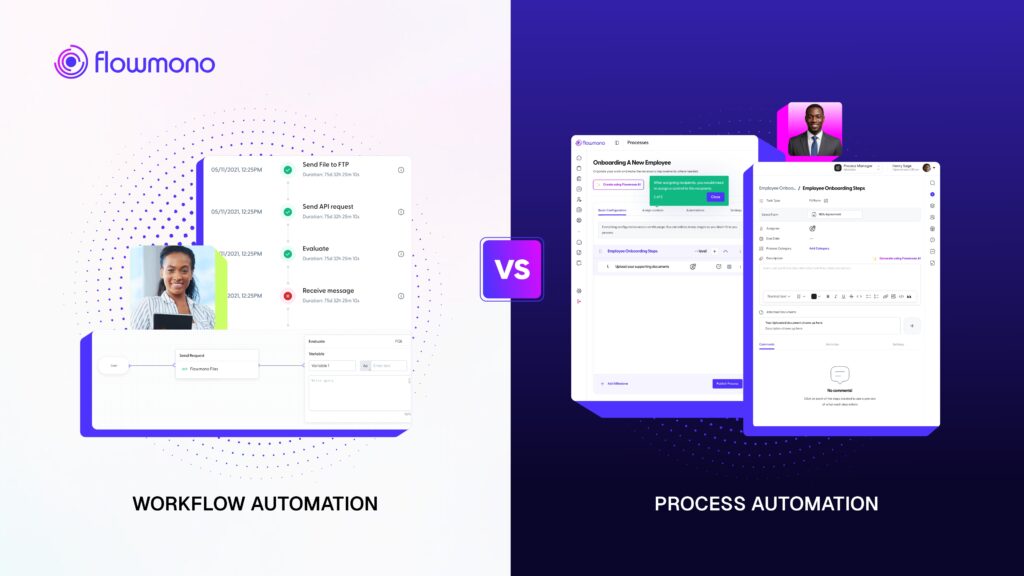
In the dynamic landscape of African and global businesses striving for peak efficiency, the terms “workflow automation” and “process automation” often surface. While seemingly interchangeable, understanding the subtle yet significant differences between them is crucial for making informed decisions about technology adoption, especially with the recent beta launch of Flowmono Automate and the upcoming release of Flowmono Process Manager.
At its core, both concepts aim to streamline operations and reduce manual effort. However, their scope and application differ, and recognizing this distinction can empower enterprises to leverage the right tools for optimal impact.
Workflow Automation: The Building Blocks of Efficiency
Think of a workflow as a sequence of specific tasks individuals or teams perform to achieve a particular, often recurring, objective. Workflow automation focuses on automating these individual sequences. It’s about taking the steps within a defined flow and using technology to execute them automatically, trigger the next step, and ensure seamless transitions.
Consider a simple example relevant to many businesses: Employee Onboarding.
Without automation, this might involve HR manually sending forms, IT manually setting up accounts, and different departments individually providing access and training materials. Workflow automation, like that offered by Flowmono Automate, can digitize this sequence:
- A trigger (e.g., a new hire record in HR) automatically initiates the workflow.
- Tasks are automatically assigned to relevant individuals (HR, IT, direct manager).
- Automated actions occur, such as sending welcome emails, creating system accounts, and scheduling introductory meetings.
- Reminders are automatically sent to ensure the timely completion of each step.
Key characteristics of workflow automation include:
- Focus on task sequences: Automating the flow of work between individuals or systems.
- Often departmental or team-specific: Addressing recurring tasks within a particular area of the business.
- Emphasis on collaboration and information flow: Ensuring the right information reaches the right people at the right time.
- Tools like Flowmono Automate excel at this: Providing a no-code, drag-and-drop interface for visually mapping out these sequences and automating the steps.
Process Automation: The End-to-End Transformation
Process automation, on the other hand, takes a broader view. It encompasses the automation of an entire end-to-end business process, which often involves multiple workflows, systems, and departments. It’s about looking at the complete value chain and identifying opportunities to automate significant portions, if not the entirety, of it.
Let’s consider a more complex example: Invoice Processing in a Business enterprise.
This process might involve:
- Receiving invoices from various vendors (potentially in different formats).
- Data entry into accounting systems.
- Routing invoices for approvals across multiple departments and individuals based on predefined rules and amounts.
- Matching invoices with purchase orders and goods received notes.
- Scheduling payments.
- Updating accounting records.
Flowmono Process Manager, with its upcoming release, is designed to tackle this level of complexity. It will allow organizations to define and manage these intricate, cross-functional processes, potentially integrating various workflows and systems into a cohesive automated flow.
Key characteristics of process automation include:
- Holistic view: Automating entire business processes from start to finish.
- Cross-functional collaboration: Involving multiple departments and systems.
- Focus on strategic goals: Aiming for significant improvements in efficiency, cost reduction, and compliance across the organization.
- Often involves integrating different technologies and workflows: Connecting various systems and automating data flow between them.
- Tools like the upcoming Flowmono Process Manager are built for this: Enabling the definition, management, and optimization of these complex, end-to-end flows.
Why Understanding the Difference Matters for Businesses
For business enterprises navigating the complexities of growth and digital transformation, understanding the distinction between workflow and process automation is vital for several reasons:
- Targeted Problem Solving: Recognizing whether a bottleneck lies within a specific team’s recurring tasks (workflow) or across a larger, multi-departmental operation (process) helps in choosing the right solution. Flowmono Automate might be the ideal starting point for streamlining departmental tasks, while Flowmono Process Manager will be crucial for tackling more complex, organization-wide processes.
- Strategic Technology Investment: Understanding the scope of automation required informs technology investment decisions. Investing in a tool primarily designed for workflow automation might not address the needs of a complex, cross-functional process. Conversely, implementing a full-fledged process automation platform for simple departmental tasks might be overkill.
- Phased Implementation: For many businesses, a phased approach to automation is often the most practical. Starting with workflow automation in key departments using Flowmono Automate can yield quick wins and build momentum before tackling more intricate process automation with Flowmono Process Manager.
- Effective Communication: Using the correct terminology ensures clear organizational communication when discussing automation initiatives and selecting appropriate tools.
Flowmono: Empowering Automation at Every Level
The introduction of Flowmono Automate and the upcoming Flowmono Process Manager positions Flowmono as a versatile partner for African and Global businesses at all stages of their automation journey.
- Flowmono Automate empowers teams to take control of their daily tasks, eliminate bottlenecks, and foster better collaboration through intuitive, no-code workflow automation. Teams can quickly build automated sequences for employee onboarding, finance approvals, internal handovers, and other routine processes, experiencing immediate gains in efficiency.
- Flowmono Process Manager, on the horizon, will provide the robust capabilities needed for organizations to define, manage, and optimize complex end-to-end workflows that span across multiple teams and systems. This will enable enterprises to tackle broader challenges, making significant improvements in overall operational efficiency and agility.
Conclusion
While the terms “workflow automation” and “process automation” are often used interchangeably, recognizing their distinct focus and scope is essential for Nigerian businesses seeking to optimize their operations. Flowmono is strategically positioned to address both needs.
By understanding these differences, Nigerian enterprises can make informed decisions, implement the right solutions at the right time, and ultimately unlock significant gains in efficiency, productivity, and growth in the evolving digital economy. The journey towards a more automated and efficient future for businesses is now more accessible than ever with Flowmono’s comprehensive suite of automation tools.
![]()